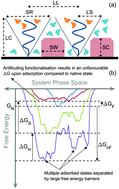Our official English website, www.x-mol.net, welcomes your
feedback! (Note: you will need to create a separate account there.)
Nanoscale in silico classification of ligand functionalised surfaces for protein adsorption resistance
Nanoscale ( IF 5.8 ) Pub Date : 2020/03/12 , DOI: 10.1039/c9nr10009a Matthew Penna 1, 2, 3, 4, 5 , Irene Yarovsky 1, 2, 3, 4, 5
Nanoscale ( IF 5.8 ) Pub Date : 2020/03/12 , DOI: 10.1039/c9nr10009a Matthew Penna 1, 2, 3, 4, 5 , Irene Yarovsky 1, 2, 3, 4, 5
Affiliation

|
Non-specific protein adsorption represents a significant challenge for the design of efficient and safe nanoparticles for biomedical applications since it may prevent functional ligands to target the desired specific receptors which can limit the efficacy of novel drug delivery systems and biosensors. The biofilm formation initiated by protein adsorption on surfaces limits the lifetime and safety of medical implants and tissue regenerative scaffolds. The development of biofouling resistant surfaces is therefore a major goal for the widespread uptake of nanomedicine. Here, we provide a relatively simple computational screening method based on the rational physically grounded criteria that may suffice in selection of surface grafted ligands for protein rejection, and test whether these criteria can be extrapolated from a specific protein to generic protein-resistant surfaces. Using all-atom molecular dynamics simulations we characterise four types of ligand functionalised surfaces at aqueous interfaces in terms of the surface hydrophobicity and ligand dynamics. We demonstrate how our hypothesised interfacial design based on the select physical characteristics of the ligated surfaces can enable the rejection of a protein from the surface. The ligand screening procedure and the detailed atomistic characterisation of the protein rejection process presented suggest that minimizing the adsorption of surface active proteins requires specific surface topographies and ligand chemistries that are able to maximise the entropic penalty associated with the restriction of the ligand dynamics and trapping interfacial water by adsorbed proteins.
中文翻译:

配体官能化表面对蛋白质吸附抗性的纳米级计算机电子分类
非特异性蛋白质吸附代表了用于生物医学应用的有效和安全的纳米颗粒设计的重大挑战,因为它可能阻止功能性配体靶向所需的特异性受体,这会限制新型药物递送系统和生物传感器的功效。由蛋白质吸附在表面上引发的生物膜形成限制了医疗植入物和组织再生支架的寿命和安全性。因此,耐生物污损表面的发展是纳米药物广泛吸收的主要目标。在此,我们基于合理的物理基础标准提供了一种相对简单的计算筛选方法,该标准可能足以选择用于蛋白质排斥的表面嫁接配体,并测试是否可以将这些标准从特定的蛋白质推断到抗蛋白质的通用表面。使用全原子分子动力学模拟,我们根据表面疏水性和配体动力学表征了水界面处的四种类型的配体官能化表面。我们展示了基于连接表面的选定物理特征的假设界面设计如何能够使蛋白质从表面排斥。
更新日期:2020-04-03
中文翻译:

配体官能化表面对蛋白质吸附抗性的纳米级计算机电子分类
非特异性蛋白质吸附代表了用于生物医学应用的有效和安全的纳米颗粒设计的重大挑战,因为它可能阻止功能性配体靶向所需的特异性受体,这会限制新型药物递送系统和生物传感器的功效。由蛋白质吸附在表面上引发的生物膜形成限制了医疗植入物和组织再生支架的寿命和安全性。因此,耐生物污损表面的发展是纳米药物广泛吸收的主要目标。在此,我们基于合理的物理基础标准提供了一种相对简单的计算筛选方法,该标准可能足以选择用于蛋白质排斥的表面嫁接配体,并测试是否可以将这些标准从特定的蛋白质推断到抗蛋白质的通用表面。使用全原子分子动力学模拟,我们根据表面疏水性和配体动力学表征了水界面处的四种类型的配体官能化表面。我们展示了基于连接表面的选定物理特征的假设界面设计如何能够使蛋白质从表面排斥。











































 京公网安备 11010802027423号
京公网安备 11010802027423号